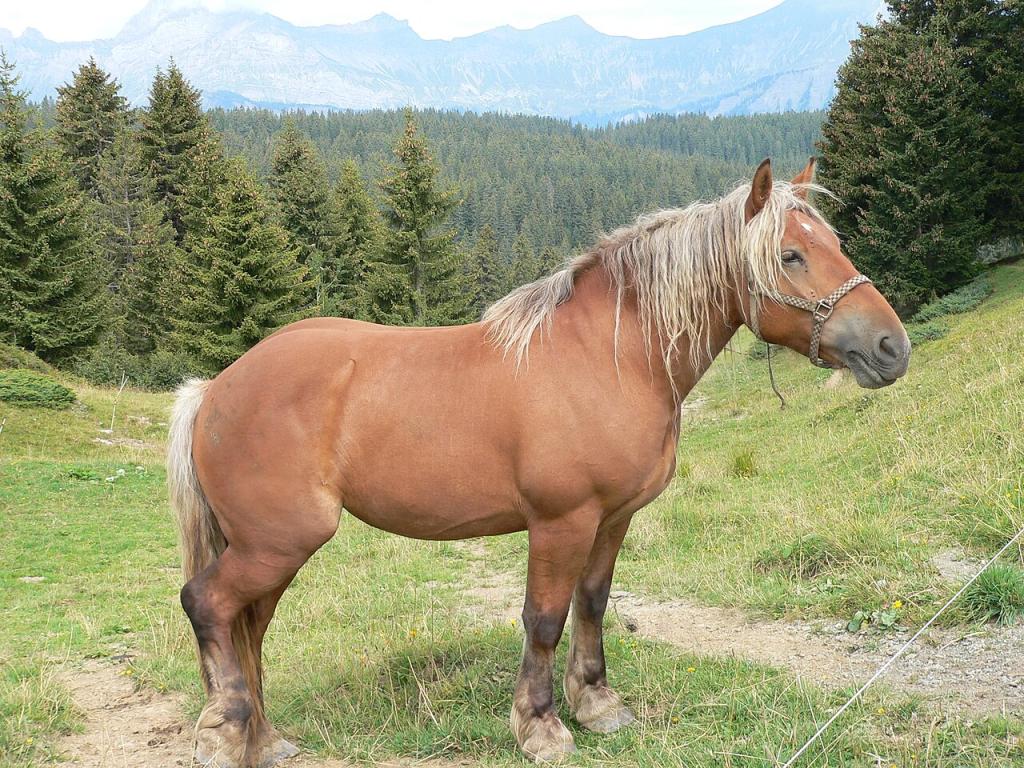
Continent: Europe
Country: France
Weight: 650 – 900 kg
Height: 150 – 165 cm
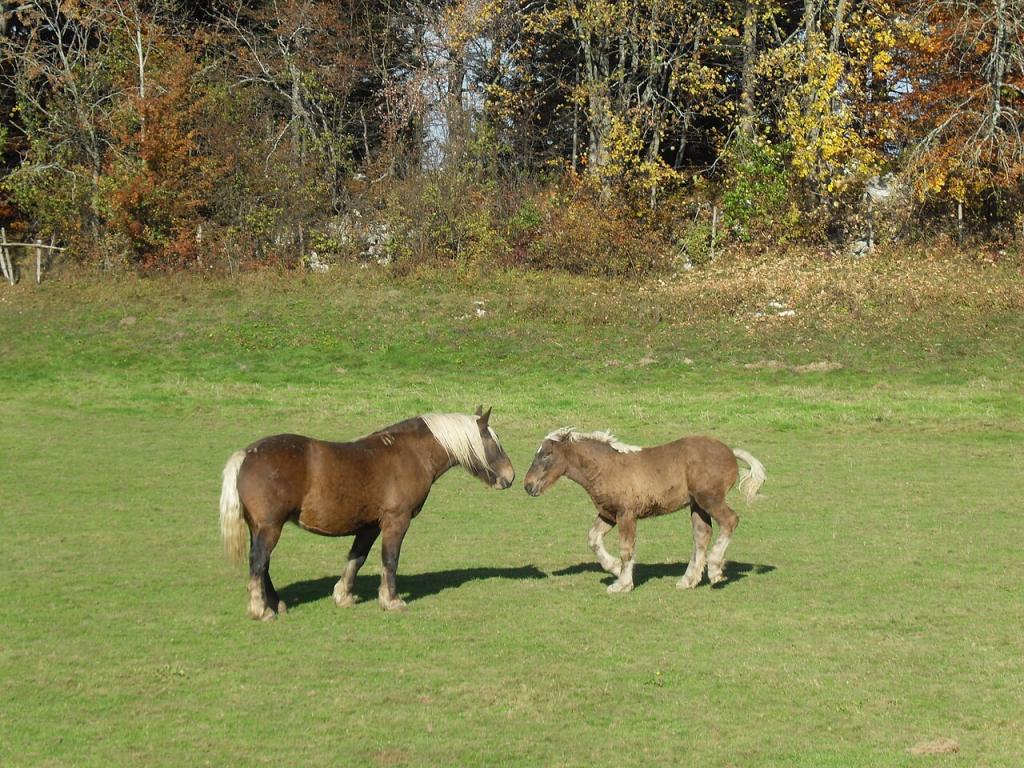
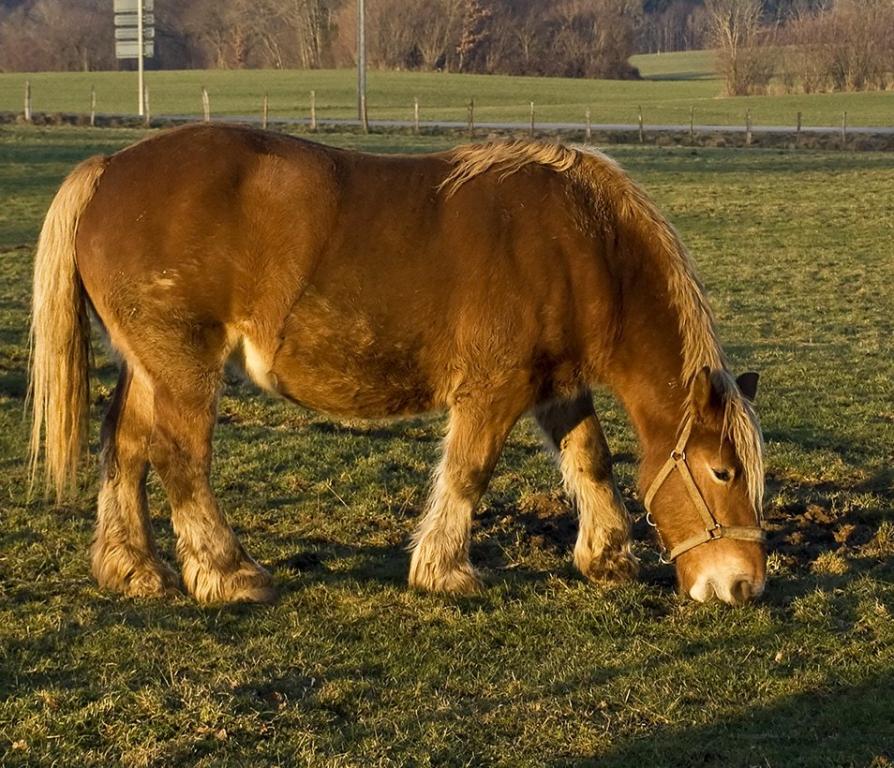
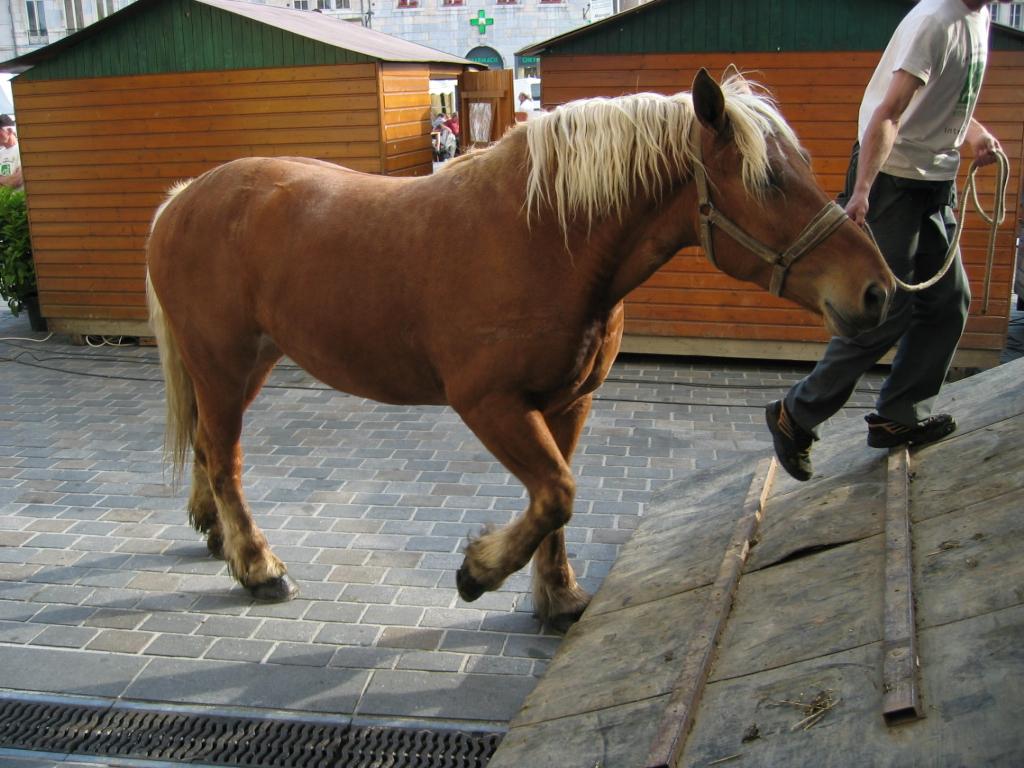

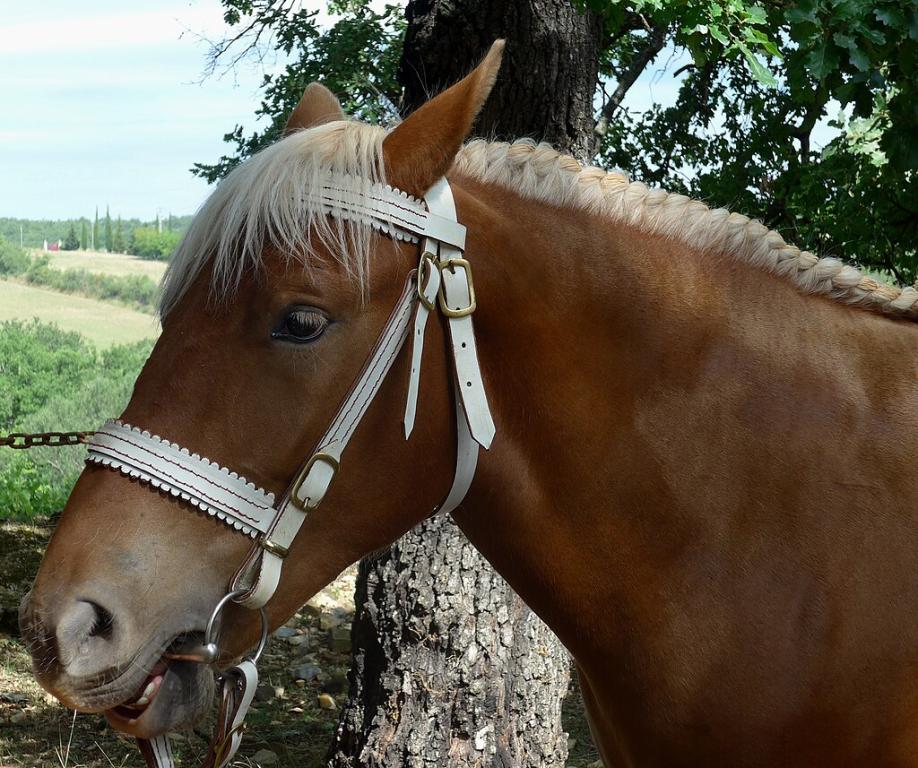
The Comtois draft horse originates from the Jura Mountains, primarily in the Franche-Comté region in eastern France. Its historical cradle lies around Maîche, in the Doubs department.
A probable descendant of the Burgundian horse introduced by Germanic tribes in the 5th century, the Comtois developed over the centuries through local crossbreeding, later influenced by heavy Germanic horses such as the Swiss Franche-Montagne and the Ardennais. It was long selected for its pulling strength, hardiness, and its ability to thrive in rugged terrain and harsh climates.
Highly valued in Comtois rural life as early as the Middle Ages, the breed became a war horse and was used for haulage under Louis XIV. In the 19th and 20th centuries, the Comtois was improved to meet both agricultural and military needs, with the occasional introduction of Ardennais and Belgian bloodlines.
The Comtois stud-book was officially established in 1919, marking the recognition of the breed as a full part of France’s equine heritage.
The Comtois Horse is primarily bred in eastern France, but its popularity and hardiness have allowed it to spread across a much wider area, including internationally.
Main breeding area (cradle of the breed) :
Bourgogne–Franche-Comté region, particularly in the departments of:
– Doubs
– Jura
– Haute-Saône
– Territoire de Belfort
It is in these mid-mountain regions, with their harsh climates and rich pastures, especially in the Haut-Doubs and Jura plateaus, that the Comtois maintains its strongest bloodlines.
Secondary breeding areas (within France) :
– Auvergne–Rhône-Alpes (Savoie, Haute-Loire, Ardèche, Ain)
– Grand Est (Vosges, Meurthe-et-Moselle)
– Nouvelle-Aquitaine (Corrèze, Dordogne, Haute-Vienne)
– Occitanie (Aveyron, Lozère)
– Pays de la Loire and Normandy: lowland breeding, mainly for driving or meat production
– Centre-Val de Loire: additional breeding for agricultural traction
The Comtois Draft Horse holds a strategic place in the equine genetic heritage of France and Europe, as a light draft breed that is both hardy, versatile, and well-suited to mountainous environments and traction work.
A founding regional breed :
Among the oldest lines of French draft horses, the Comtois has a genetic history deeply rooted in eastern France. Its distinctive morphology — lighter and drier than that of other draft breeds makes it a unique model in the equine genetic landscape.
A partial descendant of the medieval Friesian horse through ancient crosses, it was also influenced in the 19th century by the introduction of Ardennais and Belgian blood.
A contributor to the improvement of other breeds :
The Comtois has been used in various breeding programs to improve conformation, strengthen resilience, and increase fertility in other draft horse breeds. It has also contributed to:
– The production of horses for the horse meat industry (notably between 1960 and 1990)
– The development of horses adapted to traction in mountainous, forested, or vineyard areas
– The enhancement of hardiness in local or mixed populations, in France and Eastern Europe
Preserved genetic diversity :
Although the Comtois stud-book has been closed to foreign blood since the 1990s, it maintains significant genetic diversity, thanks to rigorous lineage management and balanced selection.
The breed is known for its high fertility, early maturity, and strong adaptability, making it a valuable biological resource for sustainable equine sectors.
A partner in agricultural transitions :
In the context of agroecological transition, the Comtois is increasingly seen as a key genetic player for innovative uses, such as traction in vineyards, market gardening, low-impact forestry, or the maintenance of sensitive natural areas.
Its energy efficiency, low feed requirements, and climate resilience make it an ideal candidate for tomorrow’s working horse projects.
The Comtois Horse has a millennia-old history, deeply rooted in the mountains and plateaus of eastern France. From a war horse to a key figure in sustainable traction, its evolution reflects the major transformations of rural life in the Jura and Alpine regions.
Ancient origins (Antiquity – Middle Ages) :
Robust horses were already present in the Sequani region (modern-day Franche-Comté) during the Gallo-Roman period.
The breed is partly descended from horses introduced in the 5th century by the Burgundians, a Germanic tribe.
As early as the Middle Ages, local horses were renowned for their endurance and military utility, particularly in regional armies.
War horse (16th – 18th centuries) :
The Comtois was selectively bred for use in heavy cavalry and artillery transport.
It was highly valued by the royal armies for its strength, docility, and ability to pull loads over rugged terrain.
Crossbreeding with Spanish and Neapolitan horses was carried out to refine its conformation.
Agricultural development and crossbreeding (19th century) :
The 19th century marked a shift toward agricultural and forestry traction.
To enhance power and muscular build, crossbreeding occurred with:
– the Franche-Montagne (Switzerland)
– the Ardennais
– the Belgian Draft Horse
These influences helped consolidate the Comtois type while improving its working capabilities.
Creation of the stud-book (1919) :
The Comtois Draft Horse Stud-book was officially created on September 16, 1919, with the establishment of the Breeders’ Syndicate.
Selection criteria were then defined: compact build, chestnut coat, rusticity, and harmonious conformation.
Post-mechanization decline (1950–1980) :
Like all draft breeds, the Comtois experienced a severe crisis after World War II:
– disappearance of animal traction in agriculture
– drastic population decline
– partial shift toward horse meat production, with selection focused on muscle mass and early maturity
Revival and reconversion (1980 – present) :
Starting in the 1980s, a movement to revalue living heritage revived interest in the Comtois:
– return of low-impact forestry work
– growth of recreational driving
– launch of genetic preservation programs
The so-called "postier" appearance (lighter build) is again sought in certain bloodlines, particularly for rural tourism.
Today, the Comtois stands as a symbol of Franche-Comté identity and modern ecological traction.
The Comtois Horse is known for its calm temperament, reliability at work, and great gentleness, making it a highly valued partner for both traction and leisure or therapeutic activities.
General temperament :
– Calm and well-balanced: it shows little reaction to sudden external stimuli and keeps its composure in diverse environments (forests, urban settings, crowds).
– Docile: it accepts basic training, harnessing, and daily handling with ease.
– Patient: it can remain still or work for long periods without becoming restless.
– Tolerant: it is forgiving of human mistakes, making it well-suited for beginners, children, and vulnerable individuals.
Work behavior :
– Willing: it puts its strength to use with determination when pulling or carrying loads.
– Enduring: despite its compact build, it can sustain effort over time, especially in mountainous or forested terrain.
– Obedient: it responds well to vocal commands, lunging, and driving, with a high capacity for learning.
Relationship with humans :
Very people-oriented, the Comtois often seeks contact and builds strong bonds of trust with its handler.
Its reassuring size, gentle eyes, and peaceful presence make it a favorite in animal-assisted therapy, educational centers, and rural festivals.
Social life and outdoor living :
Sociable, it integrates easily into a herd and maintains a stable hierarchical behavior.
Thanks to its hardiness, it can live outdoors year-round, provided it has access to shelter and an adequate diet.
The Comtois Horse is a gentle giant, both hardworking, patient, respectful, and rustic. These behavioral traits make it an ideal breed for multiple uses: draught work, driving, family leisure, rural tourism, and animal-assisted activities.
The Comtois Horse, like all French draft breeds, faces the challenge of finding new purposes in a post-mechanization world, but it possesses strong assets to ensure its long-term survival and modern relevance.
The breed remains one of the most numerous among French draft horses, with around 2,000 births per year over the past decade.
Thanks to a strict morphological selection policy and rigorous stud-book management, the genetic quality of the herd is maintained.
Genetic diversity monitoring programs led by IFCE and INRAE help prevent inbreeding.
Reintegration into agricultural and forestry practices :
In the context of the agroecological transition, the Comtois is finding new roles:
– In animal traction (organic farming, viticulture, market gardening, maintenance of wetlands)
– In logging operations in sensitive environments where heavy machinery cannot operate
– As a partial alternative to mechanization in low-impact farms
Tourism and cultural appeal :
The Comtois is increasingly used for:
– Tourist carriage rides (rural festivals, sightseeing tours)
– Historical and festive demonstrations (transhumance events, regional fairs, model competitions)
– Educational programs and animal-assisted activities, thanks to its calm temperament and docility
Challenges to address :
– Partial dependence on the meat industry, which remains a significant but controversial outlet
– Aging population of traditional breeders in the cradle region, requiring generational renewal
– Decline in demand for heavy draft horses, partially offset by diversified but small-scale uses
– Need to adapt to societal expectations: animal welfare, public image, and social usefulness
Toward multifunctional value :
The future of the Comtois lies in a multifunctional approach:
– As a working horse (sustainable traction)
– As a heritage breed (regional identity)
– As a leisure horse (driving, public events)
– As a genetic resource for crossbreeding programs adapted to alternative farming systems
The Comtois Horse has all the assets for a successful transition: hardiness, adaptability, high fertility, and a strong cultural identity.
Its sustainable reconversion is already underway, supported by local communities, institutions, and a new generation of breeders aware of ecological challenges.
The Comtois Horse is renowned for its robustness, longevity, and natural resistance to diseases traits inherited from its adaptation to the harsh climatic and geographic conditions of the Jura Mountains.
Natural hardiness :
The Comtois is perfectly suited to outdoor living: it tolerates cold, humidity, and temperature fluctuations very well.
It has a strong bone structure and well-developed musculature, which helps prevent injuries related to work or pulling.
Low susceptibility to common illnesses :
– Rarely affected by respiratory or digestive diseases when properly fed and maintained.
– Shows resistance to internal parasites (though regular deworming is still recommended).
– Healthy feet, with hard, well-shaped hooves, often black in color.
Longevity and maintenance :
– Lifespan: 25 to 30 years, sometimes more.
– Easy to care for: requires minimal special attention, except for:
– effective parasite management,
– regular hoof trimming (especially for unshod horses kept in open fields),
– a simple, balanced diet suited to its level of activity.
The Comtois Horse is a hardy and healthy breed, well-suited to both extensive farming systems and intensive work environments, as long as its dietary needs and physical capacities are respected.
It is a reliable horse with low veterinary costs, true to its mountain-bred origins.

Discover the basics of judging the Comtois draft horse.